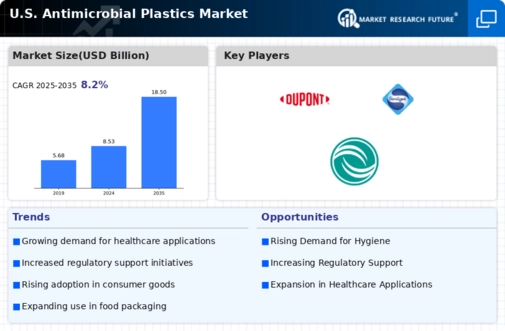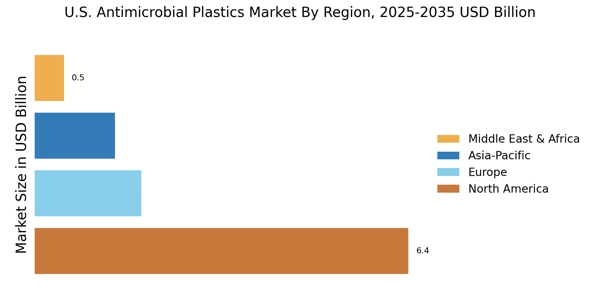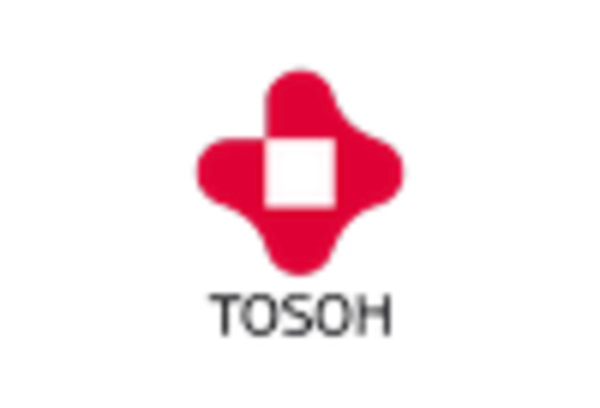Increasing Awareness of Hygiene
The U.S. Antimicrobial Plastics Market is experiencing a notable surge in demand driven by heightened awareness of hygiene and cleanliness. Consumers and businesses alike are increasingly prioritizing products that offer antimicrobial properties, particularly in environments such as hospitals, schools, and public spaces. This trend is reflected in market data, which indicates that the antimicrobial plastics segment is projected to grow at a compound annual growth rate of approximately 8% over the next five years. As awareness of the importance of hygiene continues to rise, manufacturers are likely to innovate and expand their product lines to meet consumer expectations, thereby further propelling the U.S. Antimicrobial Plastics Market.
Rising Demand in Consumer Goods
The U.S. Antimicrobial Plastics Market is witnessing a rising demand in the consumer goods sector, where antimicrobial properties are increasingly sought after in everyday products. From kitchenware to personal care items, consumers are becoming more conscious of the materials used in the products they purchase. This shift in consumer behavior is prompting manufacturers to incorporate antimicrobial technologies into their offerings, thereby enhancing product appeal and functionality. Market data indicates that the consumer goods segment is expected to grow steadily, driven by the increasing emphasis on health and wellness. As a result, the U.S. Antimicrobial Plastics Market is likely to benefit from this trend, with manufacturers focusing on innovation to meet evolving consumer preferences.
Regulatory Support and Standards
The U.S. Antimicrobial Plastics Market benefits from a robust framework of regulatory support and standards that promote the use of antimicrobial materials. Government agencies are increasingly recognizing the importance of antimicrobial plastics in various applications, particularly in healthcare and food packaging. This regulatory environment encourages manufacturers to invest in research and development, leading to the introduction of new and improved antimicrobial products. Furthermore, compliance with stringent safety and efficacy standards enhances consumer confidence, which is crucial for market growth. As a result, the U.S. Antimicrobial Plastics Market is likely to see sustained growth as regulations evolve to support innovation and safety.
Growth in the Food Packaging Sector
The U.S. Antimicrobial Plastics Market is significantly influenced by the growth in the food packaging sector, where antimicrobial plastics are increasingly utilized to extend shelf life and enhance food safety. With rising consumer demand for fresh and safe food products, manufacturers are adopting antimicrobial materials to prevent microbial contamination. Market data suggests that the food packaging segment is expected to account for a substantial share of the antimicrobial plastics market, driven by innovations in packaging technologies. This trend not only addresses consumer concerns regarding food safety but also aligns with the broader objectives of reducing food waste, thereby contributing to the overall growth of the U.S. Antimicrobial Plastics Market.
Technological Innovations in Material Science
Technological innovations in material science are playing a pivotal role in shaping the U.S. Antimicrobial Plastics Market. Advances in polymer chemistry and nanotechnology are enabling the development of more effective antimicrobial agents that can be integrated into plastic materials. These innovations not only enhance the performance of antimicrobial plastics but also expand their applications across various industries, including healthcare, consumer goods, and automotive. As manufacturers continue to explore new formulations and processing techniques, the U.S. Antimicrobial Plastics Market is poised for significant growth. The ability to create tailored solutions that meet specific industry needs is likely to drive further adoption of antimicrobial plastics.


















Leave a Comment